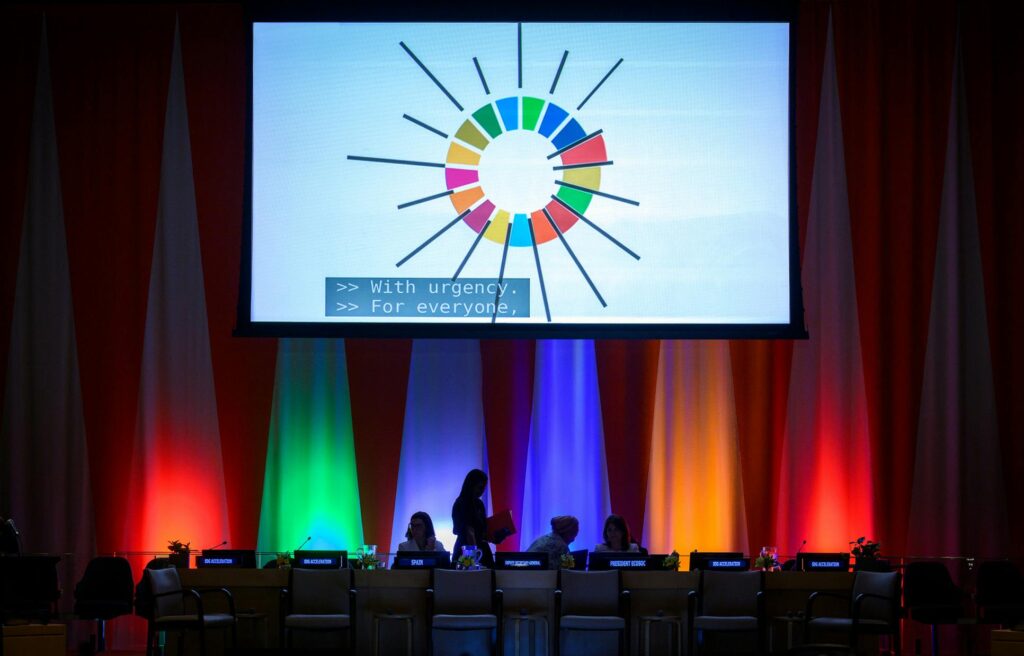

Hosted by the Executive Office of the Secretary-General and the Joint SDG Fund, HLPF special event “Keeping the SDG Promise: Pathways to Acceleration” highlights UN entities, civil society, and marginalized groups driving SDG acceleration. Photo: UN Photo / Loey Felipe
At a time when global cooperation has never been more urgent or essential, faith in the power of multilateralism is faltering. Conflict, poverty, and hunger are on the rise while progress across the Sustainable Development Goals has mostly stalled or slid backward. Amid existential challenges like climate change, the United Nations and the UN Foundation are charting a new course by bringing world leaders and everyday citizens together — online, offline, and beyond.
2024 has been a record-breaking year in all of the worst ways: It’s already the hottest year in history, with ocean temperatures soaring to new highs every day. Conflict, climate disasters, and displacement have reached unprecedented levels while human rights, especially for girls and women, are being rolled back worldwide. The UN’s 2024 SDG Report underscores the need for turbocharged action, revealing that a dismal 17% of the Global Goals’ benchmarks are currently on track for 2030.
The recent High-Level Political Forum on Sustainable Development (HLPF) — a convening held at UN headquarters in New York each July — measures our collective progress on the SDGs and this year’s HLPF focused on five in particular: SDG 1 – No Poverty; SDG 2 – Zero Hunger; SDG 13 – Climate Action; SDG 16 – Peace, Justice and Strong Institutions; and SDG 17 – Partnerships for the Goals.
For Julie Garfieldt Kofoed, Senior Director for Sustainable Development Initiatives at the UN Foundation, moments like HLPF serve as a critical checkpoint to keep nations accountable. “This is a constantly churning machine that keeps Member States’ feet to the fire,” she says.
This year 37 UN Member States presented what are known as Voluntary National Reviews (VNRs), technical reports that monitor strides and setbacks using the SDG framework’s nearly 250 statistical indicators. With the 2030 deadline for achieving the SDGs fast approaching, just a few countries have yet to present a VNR at the UN: Haiti, Myanmar, and the United States.
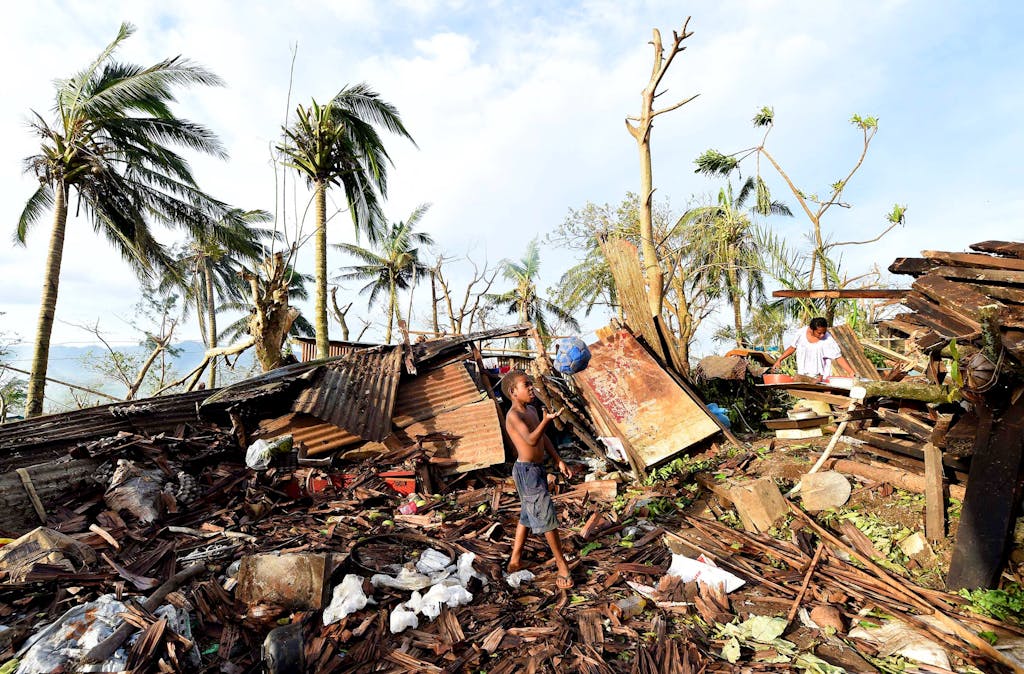
A young boy plays while his mother searches through the ruins of their family home following a cyclone in Port Vila, Vanuatu. Photo: Dave Hunt-Pool / Getty Images
A Financial Overhaul for the Long Haul
“Funding is the main means of implementation to get us on the right track,” Kofoed says of achieving the SDGs. “And we’re facing a massive $4 trillion financing gap.”
Among the four key fronts outlined by UN Secretary-General António Guterres at this year’s HLPF is boosting SDG financing. Despite such pioneering financing mechanisms as the Loss and Damage Fund, challenges to scaling up persist, even as climate threats intensify. The small island developing states of Vanuatu and Grenada, for example, just weathered the strongest Atlantic storm to form so early in the hurricane season.
In response to these shortfalls, Guterres launched his SDG Stimulus plan last year, calling for at least $500 billion per year in global investment toward the SDGs, primarily through the World Bank, the Asian Development Bank, and other multilateral development banks. In her opening remarks at this year’s HLPF, UN Deputy Secretary-General Amina Mohammed also cited the UN’s Joint SDG Fund as a “power source for flexible, catalyzing financing” by using pooled resources to encourage collaboration among UN agencies, instead of internal competition over earmarked support.
“Over the past couple of years, the issue around reform of the international financial institutions has moved from a niche conversation topic to a mainstream one,” Kofoed says. “I think in part due to the Secretary-General’s calls for an overhaul of the whole international financial architecture. He’s been a very strong advocate about the outdated nature of our current system and the inherent colonial aspects of it.”
But simply throwing more money at these complicated, interrelated issues won’t be enough. This year’s HLPF addressed other obstacles for implementation, including local capacity and inclusion. Overcoming barriers like these means examining aid effectiveness, transparency, illicit financial flows, and corruption. “The system itself needs an overhaul,” Kofoed says. “Not just the international financial architecture, but also the way in which we do development.”
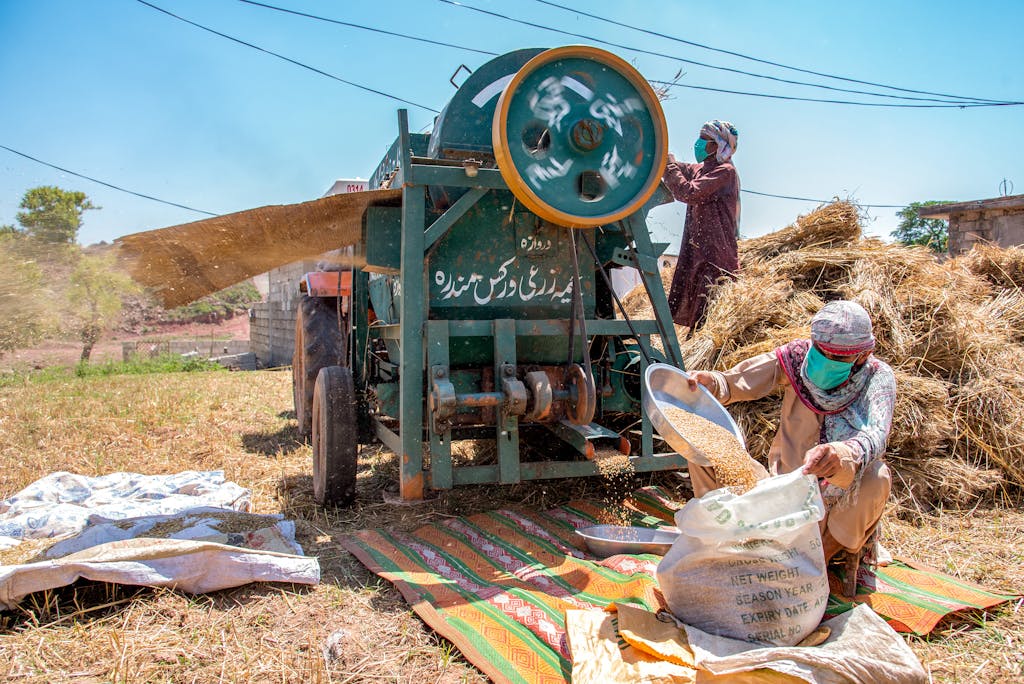
Farmers threshing wheat in Pakistan. The Financing for Development Forum, which takes place at UN Headquarters, seeks to address global development issues such as food insecurity and agrifood system resiliency. Photo: UN Photo / Rahim Mirza
Writing a New Chapter
When asked what global solidarity and collective action can accomplish, George Hampton, Executive Director for Global Policy and Multilateral Initiatives at the UN Foundation, points to our planet’s rapid 18-month timeline to develop and deliver vaccines against COVID-19 as a life-altering example. At the same time, the pandemic revealed how much the UN needs to evolve. “We have 1940s-era mechanisms for 21st-century problems,” Hampton says.
The invasion of Ukraine in 2022 similarly revealed the interconnectedness of our global challenges and the inadequacies of the current system. “It wasn’t only a humanitarian crisis or conflict. It also triggered a financial crisis, an energy crisis, a food crisis, and, eventually, a supply chain crisis that led to inflationary effects as well,” Hampton says. “This new era has brought us new tools to respond in a way that we could never have dreamed of before, but we need to make sure that the system also is up to code.”
This is exactly what the Summit of the Future in September intends to do, by breaking down silos between sectors, societies, and generations to create transformative, holistic solutions. That’s also why the Summit of the Future will tackle such a broad range of issues, from governance of space to managing AI to reforming development finance. As part of these efforts, the Summit is set to adopt the Pact for the Future, which will serve as a Paris Agreement of sorts for unifying humanity’s broader shared ambitions.
“This is a moment where we’re trying to learn how to use the best of technology, the best of science, and the best and brightest minds to be able to project and peer into the future,” says Harshani Dharmadasa, the UN Foundation’s Senior Director, Global Partnerships and Initiatives. “Because we know that the consequences of our actions and inactions today will have an enormous ripple effect for our children and our grandchildren, and we cannot be blind to that anymore.”
Discussions at the Summit could ultimately pave the way for a new international agency — “like an IPCC for artificial intelligence,” as Hampton puts it, referring to the Intergovernmental Panel on Climate Change. This new international agency would tap the planet’s leading scientists to inform policymakers and the public about the rapidly changing landscape of AI, for example.
“If there is a destination where we can tackle all the biggest challenges, including the sense of disconnection that young people and generations are feeling, it’s the UN,” Dharmadasa says. “It’s our port of call to move to the future.”
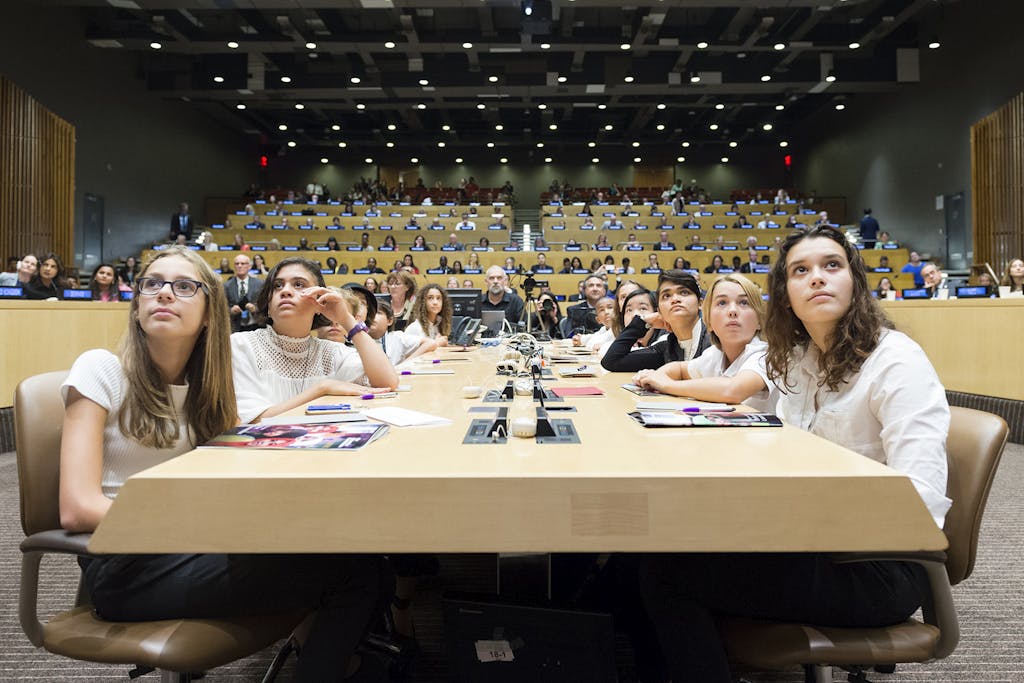
Young attendees learn about the importance of education funding at “Financing the Future: Education 2030”. For youth around the world, access to education is the key to a better world and a better future.
Photo: UN Photo/Rick Bajornas
Connecting You to the UN
Global moments such as the HLPF and Summit of the Future convenings offer crucial opportunities for information-sharing and accountability, but only if people across borders, backgrounds, and ages are engaged in the process.
“We have demographic dominance in this world, but at the same time we don’t have a say,” says Mai Sami Mohamed Ahmed, a Next Generation Fellow and advocacy officer for Save the Children. As a young Egyptian, Ahmed points out that over half of the population of young countries in Asia and Africa are under the age of 30, yet these countries are underrepresented in global decision-making.
“When we talk about young people and the challenges of meaningful participation, the first thing is tokenism and the other things are visa restrictions, language barriers, and access to the U.S. and the UN itself,” Ahmed says. She cited the UN Civil Society Conference in Nairobi earlier this spring as a promising sign of expanding geopolitical inclusion. The Conference was the first of its kind held in a developing country, and over 70% of attendees were from Africa. With most major global meetings taking place at UN headquarters in New York, prohibitive travel costs and bureaucratic hurdles often deter young people and everyday citizens from attending. “It was one of the first times that I felt like UN Member States were here to really listen,” Ahmed says. “They were not just attending events and running off, they were participating in dialogues and conversations.”
Maryna Maiboroda, Officer, Sustainable Development Initiatives at the UN Foundation, echoes this impression, saying she heard several references at HLPF to the recent Nairobi conference as an example of good practice. “These conversations and events specifically focusing on how we can be more inclusive and accessible for civil society and stakeholders are becoming much more widespread within the UN.”
“I feel like the UN is trying, the UN agencies are trying,” Ahmed says. “UN Member States, however, need to treat civil society, including children and young people, as equal partners and stakeholders.” She praises Denmark and Costa Rica for leading by example by co-launching the UNMute Initiative, a collaboration of 52 Member States and 400 nonprofits, including the UN Foundation, to highlight and expand the shrinking civic space at the UN. At the upcoming Summit of the Future, UNMute will be releasing what Kofoed refers to as a “How-to Manual” for national leaders to engage their own citizens.
Meanwhile, initiatives like Unlock the Future are mobilizing and elevating young voices on a global scale as well. The coalition, hosted by the UN Foundation and describing itself as “more than an alliance” but “a powerhouse of ambition and hope,” brings together the planet’s largest youth and youth-led organizations, including BRAC, Mercy Corps, World YMCA, and Plan International. Guided by a five-year action plan dubbed The Road to 2100, members of the Unlock the Future coalition are collaborating with experts, policymakers, and young people to reimagine how the UN system works while creating opportunities for joint action and amplifying underrepresented voices to influence the global agenda.
As part of this push, Unlock the Future is launching a series of national town halls in 2024 to harness the insight and experiences of everyday people across the globe. From Brazil to Indonesia, Sierra Leone, Sweden, Vanuatu, and beyond, this multiyear series is intended to spark intergenerational and cross-cultural dialogue.
“As we peer into the future, we know that 80% of young people will be from Africa or Asia,” Dharmadasa says. “We know that [the population of] sub-Saharan Africa will more than double in size. So when we think about the value of the UN and how we retrofit or reimagine it to be able to really deliver for people, that means delivering for those countries furthest behind by ensuring that they have infrastructure, they feel safe, they have access to health care, and they have access to equal opportunities. If they don’t have those opportunities, we’re not delivering on the SDGs.”
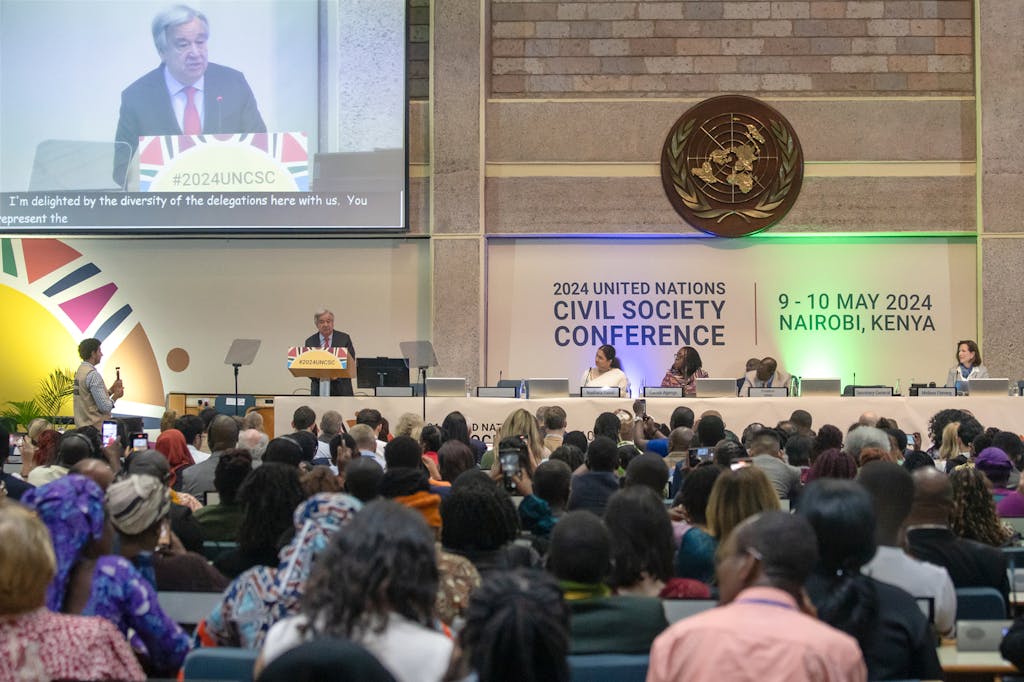
During his opening remarks at the United Nations Civil Society Conference, Secretary-General António Guterres highlights the Summit of the Future — and how civil society can mobilize for change. Photo: UN Photo / Duncan Moore
Stepping Stones to Sustainability
Running through all of these efforts and events is the goal of redefining global governance by safeguarding the equitable participation of civil society. This mission reflects an undeniable truth: Without the wisdom and buy-in of local communities, humanity can’t create effective solutions for the increasingly complex challenges we face.
“It’s a big step for an organization that, even a couple of decades ago, prided itself on the idea of being a very closed shop in terms of how Member States dealt with each other,” Hampton says. “But in an increasingly globalized world, you’re seeing recognition by both the UN and Member States that unless you have all of these stakeholders in the room, we can’t respond effectively enough.”
Global reform is often messy — and incremental. “You really need to approach this work in terms of a longer arc of progress. Everything will not come at once,” Kofoed says, likening HLPF and the upcoming Summit of the Future as “stepping stones along the way.”
In other words, global citizens need to be ready for the long haul. Because when it comes to laying out a vision for the future, our voices are vital.
“World leaders should listen to children, young people, and civil society because we come from the grassroots,” Ahmed says. “We reflect the heartbeat of our communities.”
Join the Movement
Explore what it will take to shape a better future and learn how you can get involved.

